The Next Stage of Development
~ Prologue page 2b~
~ The Study of Threes ~
http://threesology.org

Visitors as of 1st Feb 2020
| Preface page 1 | Preface page 2 | Preface page 3 |
| Preface page 1b | Preface page 2b | Preface page 3b |
| ANC Prologue Page 1 |
ANC Prologue Page 2 |
ANC Prologue Page 3 |
| ANC Prologue Page 1b |
ANC Prologue Page 2b |
ANC Prologue Page 3b |
| Communism and Societal Collapse |
| ANC Epilogue Page 1 |
ANC Epilogue Page 2 |
ANC Epilogue Page 3 |
In an attempt to analyze Communism with the intent for establishing a New Communism, though that which may arise from the analyses may not eventually come to be called "Communism" at all, but nonetheless supersedes current (and past) orientations for developing a governmental/social program more advantages and equitable for the global presence of humanity; we come to assess some evaluation of Marxism through both a direct and indirect dissection of Marx's and Engels ideas, but also from the perspectives of those who have spent time and effort examining those ideas for one or another interest of their own. (Not everyone who reads about Marx and Engels are especially interested in Communism or promoting their own Socio-political ideology. Different people have different motivations attached to their curiosity; such as simply being informed about a given idea.) Those ideas such as Maoism, Trotskyism, Leninism, etc. which are said to be variations of the Marxist theme are different perspectives but are far from being the only ones. While they have come to be "field tested" so-to-speak, in that they were at one time applied to real-world conditions, others ideas which may well be better variations have not had an opportunity to be applied. Nonetheless, all of them are perspectives which took their lead from Marx and it is therefore necessary to examine the source from which their own ideas sprung.
In the ANC
Prologue
Page 1b section which was completed before beginning this
page, three orientations were assessed as the primary criteria which provided the basis by which Marx (Engels, etc...)) established their ideas which can be
viewed as a road map. The three orientations are:
- A philosophical anthropology
- A theory of history:
- An economic and political program:
While you may agree or disagree, the point to be made is that the ideas resemble coordinate points on a map that will lead to some fortune called a Utopia. In other words it is a proposed treasure map that uses a three-patterned x, y, z points for plotting a course. Unfortunately, it is easy to see that these points are faulty. For example, while we might agree with the "philosophical anthropology" point, the next or second point concerning history necessarily involves economics and politics. Therefore, the third point might well be to include the environment. Indeed, if anyone today wanted to pursue the creation of a political and economic system, we most likely would take information from a larger stretch of time for all three points. Whereas Marx can be excused for not thinking about large expanses of time (millions and billions of years) because it was not a common consideration amongst many different types of thinkers in their respective subject interests, we of today have no excuse not to embrace an appreciation of much wider depths and lengths... that is, the overall scope.
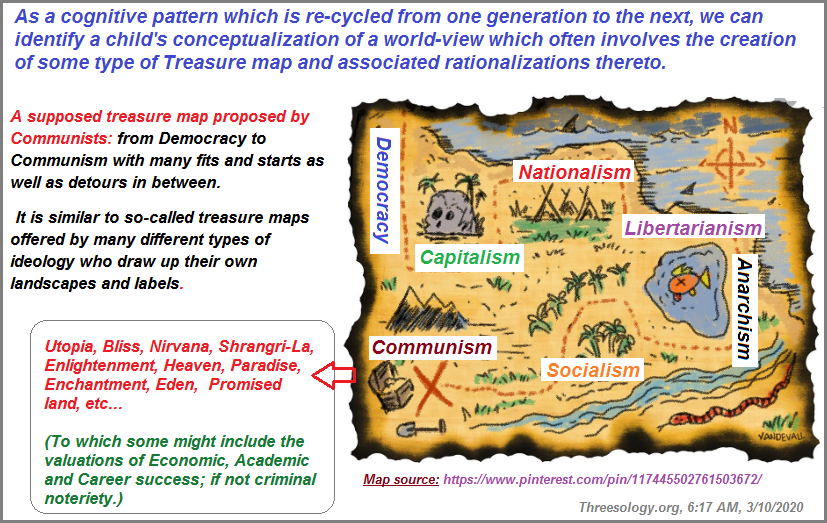
Not only did Marx use a child's perspective of coordinate (coordinating) points from which to draw up his "treasure map", but he also provided a fanciful representation of the overall terrain, (social, economic, environmental, biological, philosophical, religion, eastern philosophy, industry, technology, learning, architecture, etc...). In other words, he was not an artist who could accurately display the environment beyond the skill of portraying stick figures or cave-dwelling images in which the artist is preoccupied with copying their own hand. While he spoke of a dynamic (moving) social system, his views were inclined to fix the movement into a non-moving or slow-moving articulation of human consciousness. In other words, while his treasure map for some references fixed points, it does not speak well of the fluidic movement by which social systems operate, sometimes like a canal with controlled gates and at other times like a burst dam or tsunami.
Marx's so-called political and economic program reads like an S.O.P. (Standard Operating Procedure) to be used for a system of production, so long as the system is regulated (and thus simplistic enough) to produce one or only a very few products along a slow moving conveyor belt attended by those who are to embrace an illusion... if not delusion that their role is of importance to keep the system running smoothly and equitably, though the owners and managers of the production system receive a level of "equality" that they interpret what best suits their needs, as occurs in present day systems of unequal economics the world-over. Marx's comment which has been transitioned into a slogan: From each according to his ability, to each according to his needs, is quite probably a two-patterned (dialectic proposing itself as a 'trilectic') version of the old three precepts of justice which read as a Buddhist life-philosophy formula and can alternatively applied to other three-patterned precepts as well:
Sources:
- The Law.com dictionary
- The Three Pure Precepts
- Three wise monkeys, a two thousand years symbol explained
Another example of a precept that can be viewed as a coordinate (coordinating) system is found in Engels' Three Laws of Dialectics:
Engels discusses three principal laws of dialectics: the law of the transformation of quantity into quality, and vice versa; the law of the interpenetration of opposites; and the law of the negation of the negation. He takes the experimental results of the individual sciences, sifts and synthesizes them, to show that these dialectical laws are really laws of development in nature and therefore valid for theoretical natural science.
Engels on Dialectics of Nature (December 1940) by Wm.F. Warde
The above article describes the usage of a two-patterned "comprehension" of motion in nature by Engels and thus unknowingly provides information that the orientation is comprehensively not taking into account the need for a 3 coordinate requirement for locating a position in 3-dimensional space. In other words, it was an acceptable means at the time to use pattern-of-two in ideological pursuits and constructs upon which a supposed third point of reference could be added to give the appearance of a substantially observable progress in thinking but in actuality provided us with an embellished dichotomy. In other words, both Engels and Marx, as well as their contemporaries used an underlying Hegelian brand of dialectical methodology:
"Hegel's dialectics" refers to the particular dialectical method of argument employed by the 19th Century German philosopher, G.W.F. Hegel, which, like other "dialectical" methods, relies on a contradictory process between opposing sides.
Hegel’s description of his dialectical method Hegel provides the most extensive, general account of his dialectical method in Part I of his Encyclopaedia of Philosophical Sciences, which is often called the Encyclopaedia Logic. The form or presentation of logic, he says, has three sides or moments. These sides are not parts of logic, but, rather, moments of "every logical concept", as well as "of everything true in general".
Stanford Encyclopedia of Philosophy: Hegel’s Dialectics (First published Fri. Jun 3, 2016) |
However, inasmuch as the foregoing explanation is of value to many scholars, the average person may be most familiar with the trio of "Major Premise- Minor Premise- Conclusion" or Thesis- Anti-these- Synthesis. However, let me also include several other three-patterned philosophical distinctions so as not to be accused of having so few examples:
| St. Augustine's Philosophy: | Memory ~ Understanding ~ Will |
| Comte's Philosophy: | Great Being ~ Great Medium ~ Great Fetish |
| Hegel's 3 Spirits: | Subjective Spirit ~ 0bjective Spirit ~ Absolute Spirit |
| Plotinu's Philosophy: | One ~ One Many ~ One and Many |
| Aristotle's 3 Unities: | Unity of Action ~ Unity of Time ~ Unity of Place |
| Sir F. Bacon's 3 Tables: | Presence ~ Absence ~ Degree |
| Thomas Hobbes's 3 Fields: | Physics ~ Moral Philosophy ~ Civil Philosophy |
| Immanuel Kant's 3 Critiques: | Pure Reason ~ Practical Reason ~ Judgment |
| Averroes's 3 Commentaries: | Little ~ Middle ~ Great |
| Karl Marx's 3 isms: | Communism ~ Socialism ~ Capitalism |
| Woodrow Wilson's 3 isms: | Colonialism ~ Racism ~ Anti-Communism |
| Hippocrates's Mind Disorders: | Mania ~ Melancholia ~ Phrenitis |
| Emile Durkeim's 3 Suicides: | Egoistic ~ Altruistic ~ Anomic |
| D. Liesman's 3 Social Characters: | Tradition-directed ~ Inner-directed ~ Other-directed |
| Erich Fromm's 3 Symbols: | The Conventional ~ The Accidental ~ The Universal |
| Pythagoras's "fusion" idea: | Monarchy ~ Oligarchy ~ Democracy (into harmonic whole) |
| M.L. King Jr.'s "Middle Road": | Acquiescence ~ Nonviolence ~ Violence |
| Kierkegaard's 3 Stages: | Aesthetic ~ Ethical ~ Religious |
| Husserl's 3 Reductions: | Phenomenological ~ Eidetic ~ Religious |
| St. Augustine's 3 Laws: | Divine Law ~ Natural Law ~ Temporal, or positive Law |
| Witness Stand "Laws": | Tell the Truth ~ The whole Truth ~ Nothing but the Truth |
| Titus Carus's 3 Ages: | Stone Age ~ Bronze Age ~ Iron Age |
| Feuerbach's 3 Thoughts: | God, 1st Thought ~ Reason, 2nd ~ Man, 3rd |
| Magnus's 3 Universals: | Ante Rem ~ In Rem ~ Post Rem |
| Max Weber's 3 Authorities: | Traditional ~ Charismatic ~ Legal-rational |
| F. de Sausure's 3 "Signs": | Sign ~ Signified ~ Signifier |
| Charles Pierces 3 "Signs": | Qualisign ~ Sinsign (token) ~ Legisign |
| John Keynes's 3 Eras: | Scarcity ~ Abundance ~ Stabilization |
| George Mead's 3 Distinctions: | Self ~ I ~ Me |
| Sun Yat-sen's 3 Great Principles: | Minzu zhuyi (Nationalism)- Minquan (rights of the people)- Minsheng (people's livelihood) |
| Thrasher's 3-group Gangs: | Inner Circle ~ Rank & File ~ Fringers |
| Theodore Parker's 3-for-All: | Of All the people - By All the people - For All the peopl |
| Abe Lincoln's 3-For-All: (He removed the "all" from Theodore Parker's sermon which influence his variation.) |
Of the People ~ By the People ~ For the People |
| Jesus Christ's 3 Praises: | In the name of the Father ~ Son ~ Holy Spirit |
| Samuel Clemmons' 3 lies: (Mark Twain) |
Lies ~ Damned Lies ~ Statistics |
| Descartes 3 Kinds of Ideas: | Innate- Adventitious- Factitious |
|
Thesis ~ Antithesis ~ Synthesis Indulgence ~ "Middle Way" ~ Ascetism Major Premise ~ Minor Premise ~ Conclusion Contradiction ~ Excluded Middle ~ Identity Principal | ||
| "God-ology": Omnipresent Omnipotent Omniscient |
"Metaphysics-ology": What is real How change comes What is mind |
Marxian "Dialectology": Unity of opposites Quantity & quality Negation of negation |
| Epistemology: How we know What is truth What is mind |
Axiology: Nature of good Nature of beautiful Nature of religious |
Ontology: Quality (1st-ness) Relation (2nd-ness) Representation (3rd-ness) |
- 3 times the fool: You can fool some people some of the time - Some people all the time - But not all people all the time.
- 3 traditional syllogism forms: Categorical - Hypothetical - Disjunctive
- 3-patterned basic adult syllogism: All ravens are black - Jack is a raven - Therefore, Jack is black.
- 3-patterned basic child syllogism: Fuzzy Wuzzy was a bear - Fuzzy Wuzzy had no hair - Fuzzy Wuzzy wasn't fuzzy was he?
Nonetheless, in all respects, the three references represent an attempted assertion of a coordinate system of cognitive activity. Metaphorically described as a set of map coordinates that use words instead of numbers or the characteristic X- Y- Z axis of geometry, the usage of a wrong, incorrect, vague, or otherwise sketchy symbol can produce a map of a terrain that may be in part or in whole an imaginative landscape created by the map maker. This is similar to the effort of getting some people to provide you with directions over a route you may already know, and thus become aware of how inaccurate and inefficient some people are (Like Marx and other Communists) when striving to provide a map for the development of a government and economic system to benefit humankind. Though the he Landscape one sees may be similar to how you see it, they can not describe their perceptions with landmarks which provide you with an understandable familiarity in which to navigate. Hence, we find many people taking the "coordinates" provided by Marx and Engels (and others) and adapting them to the (social/economic/religious, etc...) terrain(s) they think they perceive more.... or less accurately. Thus, again, we have variations of Marxism by those who apparently are using incorrect coordinates by which humanity can use to reach the stated treasure, yet think that it is not the coordinated provided by Marx, but their inability to follow the directions correctly. They never think to imagine that Marx's coordinates are better suited to a fixed environment that he perceived, instead of the actual fluidic one which exists. Not only did Marx provide the wrong coordinates, but insisted upon using them in the wrong terrain.
In order to understand the presence of different coordinate systems and to distinguish the usage of what appears to be a Cartesian system by Marx and Engels (as well as their many contemporaries in different areas of research), let me provide some graphic examples, though to the embellished dichotomy employed by Mark and Engels in their dialectical materialism let us be reminded of the "moral compass" expression where some interpret this solely in the terrain dealing with the various landscapes of good versus bad or evil, while others delineate a point somewhere between the extreme points and call it a grey area, with the two opposing points as being white and grey:
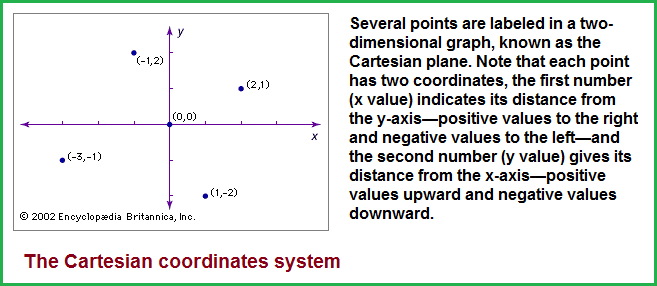
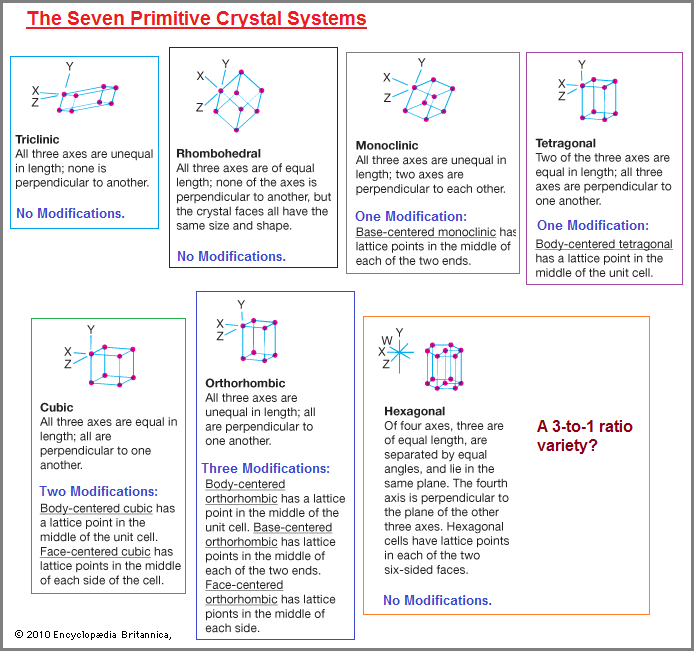
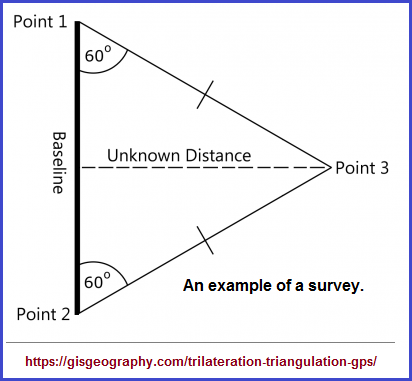
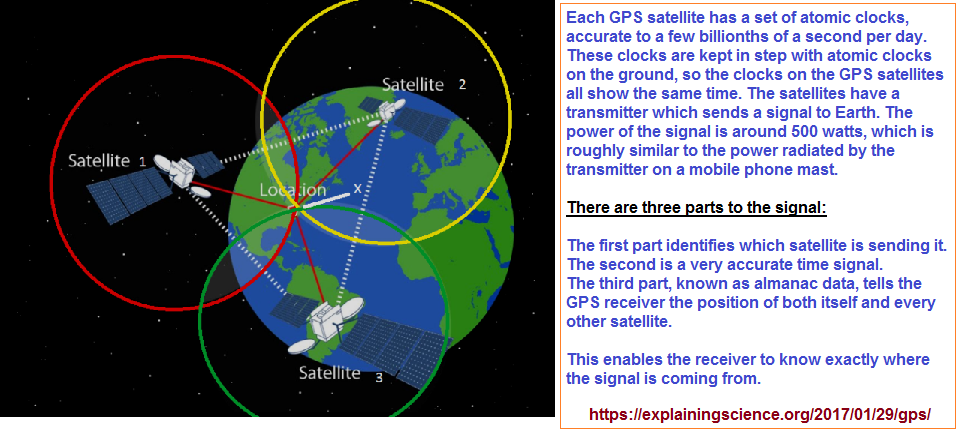

Let us also include a reference to and about Einstein's theory of relativity:
The impact of relativity has not been limited to science. Special relativity arrived on the scene at the beginning of the 20th century, and general relativity became widely known after World War I—eras when a new sensibility of "modernism" was becoming defined in art and literature. In addition, the confirmation of general relativity provided by the solar eclipse of 1919 received wide publicity. Einstein's 1921 Nobel Prize for Physics (awarded for his work on the photon nature of light), as well as the popular perception that relativity was so complex that few could grasp it, quickly turned Einstein and his theories into cultural icons. The ideas of relativity were widely applied—and misapplied—soon after their advent. Some thinkers interpreted the theory as meaning simply that all things are relative, and they employed this concept in arenas distant from physics. The Spanish humanist philosopher and essayist José Ortega y Gasset, for instance, wrote in The Modern Theme (1923):
The revolutionary aspect of Einstein's thought was also seized upon, as by the American art critic Thomas Craven, who in 1921 compared the break between classical and modern art to the break between Newtonian and Einsteinian ideas about space and time. Some saw specific relations between relativity and art arising from the idea of a four-dimensional space-time continuum. In the 19th century, developments in geometry led to popular interest in a fourth spatial dimension, imagined as somehow lying at right angles to all three of the ordinary dimensions of length, width, and height. Edwin Abbott's Flatland (1884) was the first popular presentation of these ideas. Other works of fantasy that followed spoke of the fourth dimension as an arena apart from ordinary existence. Einstein's four-dimensional universe, with three spatial dimensions and one of time, is conceptually different from four spatial dimensions. But the two kinds of four-dimensional world became conflated in interpreting the new art of the 20th century. Early Cubist works by Pablo Picasso that simultaneously portrayed all sides of their subjects became connected with the idea of higher dimensions in space, which some writers attempted to relate to relativity. In 1949, for example, the art historian Paul LaPorte wrote that "the new pictorial idiom created by [C]ubism is most satisfactorily explained by applying to it the concept of the space-time continuum." Einstein specifically rejected this view, saying, "This new artistic 'language' has nothing in common with the Theory of Relativity." Nevertheless, some artists explicitly explored Einstein's ideas. In the new Soviet Union of the 1920s, for example, the poet and illustrator Vladimir Mayakovsky, a founder of the artistic movement called Russian Futurism, or Suprematism, hired an expert to explain relativity to him. The widespread general interest in relativity was reflected in the number of books written to elucidate the subject for non-experts. Einstein's popular exposition of special and general relativity appeared almost immediately, in 1916, and his article on space-time appeared in the 13th edition of Encyclopædia Britannica in 1926. (See the classic article "space-time.") Other scientists, such as the Russian mathematician Aleksandr Friedmann and the British astronomer Arthur Eddington, wrote popular books on the subjects in the 1920s. Such books continued to appear decades later. When relativity was first announced, the public was typically awestruck by its complexity, a justified response to the intricate mathematics of general relativity. But the abstract, non-visceral nature of the theory also generated reactions against its apparent violation of common sense. These reactions included a political undertone; in some quarters, it was considered undemocratic to present or support a theory that could not be immediately understood by the common person. In contemporary usage, general culture has accepted the ideas of relativity—the impossibility of faster-than-light travel, E = mc2 (Energy equals Mass times the speed of light squared), time dilation and the twin paradox, the expanding universe, and black holes and wormholes—to the point where they are immediately recognized in the media and provide plot devices for works of science fiction. Some of these ideas have gained meaning beyond their strictly scientific ones; in the business world, for instance, "black hole" can mean an unrecoverable financial drain. Philosophical considerations In 1925 the British philosopher Bertrand Russell, in his ABC of Relativity, suggested that Einstein's work would lead to new philosophical concepts. (Russell's thoughts were also expressed the next year in the 13th edition of Encyclopædia Britannica; see the classic article "Relativity: Philosophical Consequences.") Relativity has indeed had a great effect on philosophy, illuminating some issues that go back to the ancient Greeks. The idea of the ether, invoked in the late 19th century to carry light waves, harks back to Aristotle. He divided the world into earth, air, fire, and water, with the ether (aether) as the fifth element representing the pure celestial sphere. The Michelson-Morley experiment and relativity eliminated the last vestiges of this idea. Relativity also changed the meaning of geometry as it was developed in Euclid's Elements (c. 300 BC). Euclid's system relied on the axiom "a straight line is the shortest distance between two points," among others that seemed self-evidently true. Straight lines also played a special role in Euclid's Optics as the paths followed by light rays. To philosophers such as the German Immanuel Kant, Euclid's straight-line axiom represented a deep level of truth. But general relativity makes it possible scientifically to examine space like any other physical quantity—that is, to investigate Euclid's premises. It is now known that space-time is curved near stars; no straight lines exist there, and light follows curved geodesics. Like Newton's law of gravity, Euclid's geometry correctly describes reality under certain conditions, but its axioms are not absolutely fundamental and universal, for the cosmos includes non-Euclidean geometries as well. Considering its scientific breadth, its recasting of people's view of reality, its ability to describe the entire universe, and its influence outside science, Einstein's relativity stands among the most significant and influential of scientific theories. Sidney Perkowitz: Charles Howard Candler Professor of Physics, Emory University, Atlanta. Author of Empire of Light and others. "relativity." Encyclopædia Britannica Ultimate Reference Suite, 2013. |
Note: let us reference the idea of 4-dimensions as a 3-to-1 ratio idea. Alternative references of this cognitive pattern can be found here: Three to One ratios page A.
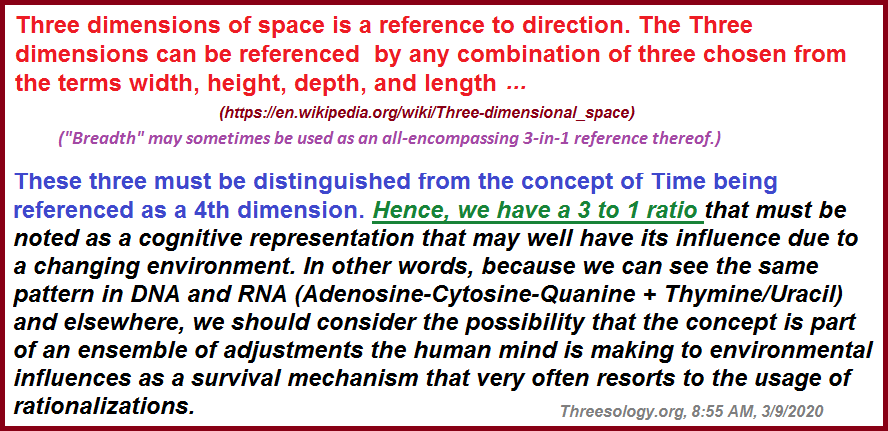
with a reference to geometry, since Marxism is, in a sense, a reference the geometry of society, let us make a note about solids:
Regular solids
Regular polyhedra are the solid analogies to regular polygons in the plane. Regular polygons are defined as having equal (congruent) sides and angles. In analogy, a solid is called regular if its faces are congruent regular polygons and its polyhedral angles (angles at which the faces meet) are congruent. This concept has been generalized to higher-dimensional (coordinate) Euclidean spaces.
Whereas in the plane there exist (in theory) infinitely many regular polygons, in three-dimensional space there exist exactly five regular polyhedra. These are known as the Platonic solids: the tetrahedron, or pyramid, with 4 triangular faces; the cube, with 6 square faces; the octahedron, with 8 equilateral triangular faces; the dodecahedron, with 12 pentagonal faces; and the icosahedron, with 20 equilateral triangular faces.
In four-dimensional space there exist exactly six regular polytopes, five of them generalizations from three-dimensional space. In any space of more than four dimensions, there exist exactly three regular polytopes—the generalizations of the tetrahedron, the cube, and the octahedron.
Benno Artmann: Professor emeritus of mathematics at the University of Goettingen, Goettingen, Germany. Author of Euclid: The Creation of Mathematics.
"Euclidean geometry." Encyclopædia Britannica Ultimate Reference Suite, 2013.
Marx and Engels were referencing basic math and basic geometry in their philosophical orientations, except that many readers can not recognized the use of "story problems" in their descriptions. Like many a teacher who presents students with equations which involve sentences aligned in a story book fashion— whose content must be reconfigured into a number equation— the mindset of many readers are not necessarily inclined to see numbers and an associated equation being referenced. And when I say "equation" I am not speaking of something sophisticated, but that which is a basic arithmetic problem. The word "equation" can be falsely used to interpret a level of sophistication which is not being used. Like the "stick figure" landscape of sociological considerations made my Marx and Engels, their ideas are presented in a very primitive pattern concealed by a language used by intellectuals who use intellectualization as a defence mechanism and not as a system advancing a greater clarity of perception. Let us take for example the following:
"Capitalist production develops the technique and the combination of the process of social production only by exhausting at the same time the two sources from which all wealth springs: the earth and the worker." According to the Marxist dialectic, these fundamental contradictions can only be resolved by a change from capitalism to a new system.
"Marxism." Encyclopædia Britannica Ultimate Reference Suite, 2013
Marx did not have the insight to realize that the bigger issue is that of an incrementally deteriorating environment which exhausts all life forms as well. Whereas Capitalism can and does play a role in the deterioration of the Earth and the Worker, so does the environment itself. Capitalism nor the Earth nor the Worker are standing still. All three of are expressed symbols of an erosion taking place by way of the incremental deterioration of the planetary system. Marxism looks upon this three-point referencing system as if it were static when in fact it is dynamic. Marx did not incorporate enough motility into his ideas. Whereas he spoke of mobility, his ideas speak in a circular fashion though he portrayed them in a linear fashion consisting of a basic 3 point dot-to-dot configuration consisting of Democracy → Socialism → Communism... which does not automatically disinclude zig-zag digressions, but does illustrate a type of road map with an era-specific legend (that sometimes today is referred to as the "small print" on a legal document):
From a "Natural Philosophy" orientation to which many Germans were ascribing to before, during and after Marx/Engels era... then to a "Marxist Ideology" which encompassed all such philosophies under one banner, we have the following excerpt from the above noted Britannica article on Marxism:
In response to criticism of Marx's ideas by a socialist named Eugen Dühring, Engels published several articles that were collected under the title Herr Eugen
Dührings Umwälzung der Wissenschaft (1878; Herr Eugen Dühring's Revolution in Science, better known as Anti-Dühring), and an unfinished work, Dialektik und
Natur (Dialectics of Nature), which he had begun around 1875–76. The importance of these writings to the subsequent development of Marxism can be seen from
Lenin's observation that Engels "developed, in a clear and often polemical style, the most general scientific questions and the different phenomena of the past
and present according to the materialist understanding of history and the economic theory of Karl Marx." But Engels was driven to simplify problems with a view
to being pedagogical; he tended to schematize and systematize things as if the fundamental questions were settled. The connections that he thus established
between some of Marx's governing ideas and some of the scientific ideas of his age gave rise to the notion that there is a complete Marxist philosophy. The
idea was to play a significant role in the transition of Marxism from a "critique of daily life" to an integrated doctrine in which philosophy, history, and
the sciences are fused.
Date of Origination: Monday, March 9th, 2020... 3:46 AM
Initial Posting: Tuesday, March 10th, 2020... 7:31 AM
Updated Posting: Sunday, May 24th, 2020... 10:22 AM
Herb O. Buckland
herbobuckland@hotmail.com
